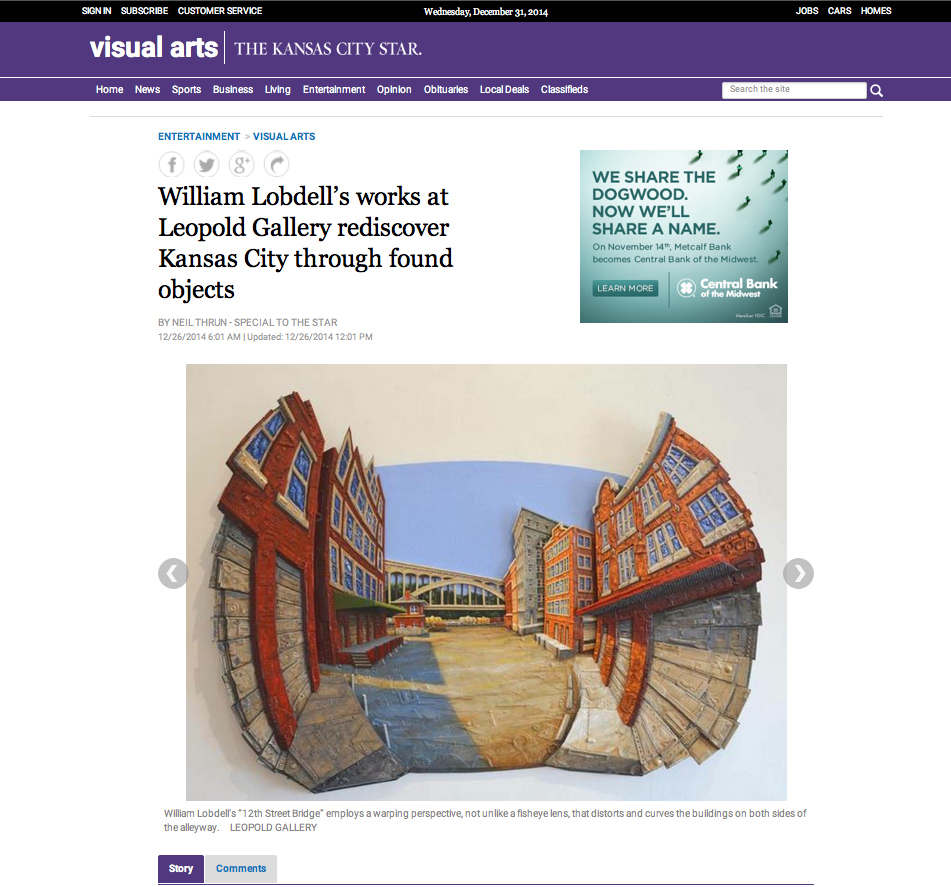
William Lobdell’s depictions of Kansas City landmarks at the Leopold Gallery are an ingenious fusion of sculpture and painting.
He starts with flat perspective drawings, then adds actual three-dimensional depth by incorporating small found objects like soda can pull tabs, bread clips and washers in his scenes.
The results are an uncanny combination of illusion and reality, and a compelling reflection on grandeur of our city and the rubbish that clutters its streets.
“Union Station II” is a good example of Lobdell’s techniques. Drawn in three-point perspective, the tan and emerald facade of Union Station appears to be a perfectly rendered drawing of the historic building. But a closer look reveals that while mostly a flat painting, various layers of board have been painted and curved to enhance the perspective effect.
Complementing this illusion of depth and flatness, dozens of small flat objects are glued onto the artwork and painted over so they blend into the illusion, breaking up the large flat planes of the artwork with an irregular texture.
Lobdell depicts other KC locales, including the downtown skyline and the River Market. “12th Street Bridge” shows the iconic double-decker viaduct from an alley down in the Bottoms.
Created with the same technique as the other works, the distant bridge is flanked by stacked panels that show the buildings along the alley. Rather than the strict three point perspective of “Union Station II,” “12th Street Bridge” employs a warping perspective, not unlike a fish-eye lens, that distorts and curves the buildings on both sides of the alleyway.
Again in this work, Lobdell utilizes small, flat, found objects to give the panels texture before painting over them.
It would be easy to dismiss Lobdell’s use of found objects as merely decorative, as his impressive optical illusions would likely function without them. But placing these small bits of rubbish onto the paintings has deeper implications.
We residents of Kansas City are often very proud of our great works of architecture, our parks, rivers and scenic vistas. It is one of the few things that can actually unite the entire region.
But walking around KC with your eyes to the ground, it doesn’t take long to notice the city has a serious problem with litter and trash. Nearly everywhere you go, you see plastic-foam cups, beer cans, bits of paper, scraps of food and plastic bags. In some neighborhoods it isn’t uncommon to see moldy couches, broken TVs and mattresses with the spray-painted words “bed bugs” lying on the curb for weeks
By putting little bits of detritus all over Kansas City’s landmarks, Lobdell is making a critical point. Our city is gleaming and clean only when viewed from a safe distance. By painting over the found objects, Lobdell is mimicking the whitewashing of the city, like those sanitized video clips taken from helicopters played during KC’s televised sporting events. Like a buffet that’s been out too long, the food looks great until you put it under a microscope and see the bacteria taking hold.
In conjunction with Lobdell’s “Sculptures of the City,” the gallery is also showing expansive Midwestern landscapes by Phil Epp in an exhibit titled “Phil Epp: Paintings of the Prairie.”
ON EXHIBIT
“William Lobdell: Sculptures of the City” runs concurrently with “Phil Epp: Paintings of the Prairie” at the Leopold Gallery, 324 W. 63rd St., through Dec. 31. Hours are 10 a.m. to 6 p.m. Monday through Friday and 10 a.m. to 5 p.m. Saturday. For more information, 816-333-3111 or go toLeopoldGallery.com.
Read more here: http://www.kansascity.com/entertainment/visual-arts/article4791177.html#storylink=cpy